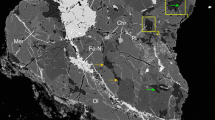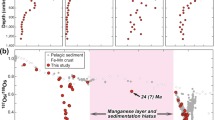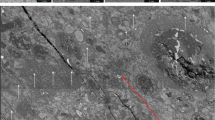Abstract
Cretaceous/Tertiary boundary sediments are now widely recognized to contain the record of a large asteroid or comet impact event1, probably at the site of the Chicxulub crater on the Yucatan peninsula2. After nearly two decades of intensive research, however, much remains unknown about the specific nature of the projectile and of the impact event itself. Here we describe a 2.5-mm fossil meteorite found in sediments retrieved from the Cretaceous/Tertiary boundary in the North Pacific Ocean that we infer may be a piece of the projectile responsible for the Chicxulub crater. Geochemical and petrographic analyses of this meteorite indicate that it probably came from a typical metal- and sulphide-rich carbonaceous chondrite rather than the porous aggregate type of interplanetary dust considered typical of cometary materials3. The fact that meteorite survival should be enhanced by impacts at low (asteroidal) velocities4 also implies that this meteorite had an asteroidal rather than a cometary origin.
This is a preview of subscription content, access via your institution
Access options
Subscribe to this journal
Receive 51 print issues and online access
$199.00 per year
only $3.90 per issue
Buy this article
- Purchase on Springer Link
- Instant access to full article PDF
Prices may be subject to local taxes which are calculated during checkout



Similar content being viewed by others
References
Alvarez, L. W., Alvarez, W., Asaro, F. & Michel, H. V. Extraterrestrial cause for the Cretaceous-Tertiary extinction. Science 208, 1095–1108 (1980).
Hildebrand, A. R. et al. Chicxulub crater: A possible Cretaceous/Tertiary boundary impact crater on the Yucatán Peninsula, Mexico. Geology 19, 867–871 (1991).
Brownlee, D. E. Cosmic dust: collection and research. Annu. Rev. Earth Planet. Sci. 13, 147–173 (1985).
Pierazzo, E., Kring, D. A. & Melosh, H. J. Hydrocode simulation of the Chicxulub impact event and the production of climatically active gases. J. Geophys. Res. E (submitted).
Rea, D. K., Leinen, M. & Janecek, T. R. Geologic approach to the long-term history of atmospheric circulation. Science 227, 721–725 (1985).
Kyte, F. T., Bostwick, J. A. & Zhou, L. The Cretaceous-Tertiary boundary on the Pacific plate: composition and distribution of impact debris. Geol. Soc. Am. Spec. Pap 307, 389–401 (1996).
Kyte, F. T., Bostwick, J. A. & Zhou, L. Identification of the Cretaceous-Tertiary boundary at ODP Site 886, ODP Site 803, and DSDP Site 576. Proc. ODP Sci. Res. 145, 427–434 (1995).
Bostwick, J. A. & Kyte, F. T. The size and abundance of shocked quartz in Cretaceous-Tertiary boundary sediments from the Pacific basin. Geol. Soc. Am. Spec. Pap. 307, 403–415 (1996).
Kyte, F. T. & Bostwick, J. A. Magnesioferrite spinel in Cretaceous-Tertiary boundary sediments of the Pacific basin: Hot, early condensates of the Chicxulub impact? Earth Planet. Sci. Lett. 132, 113–127 (1995).
Thorslund, P. & Wickman, F. E. Middle Ordovician chondrite in fossiliferous limestone from Brunflo, central Sweden. Nature 289, 285–286 (1981).
Thorslund, P., Wickman, F. E. & Nystrom, J. A. The Ordovician chondrite from Brunflo, central Sweden, I. General description and primary minerals. Lithos 17, 87–100 (1984).
Blanchard, M. B., Brownlee, D. E., Bunch, T. E., Hodge, P. W. & Kyte, F. T. Meteroid ablation spheres from deep-sea sediments. Earth Planet. Sci. Lett. 46, 178–190 (1980).
Zolensky, M., Barrett, R. & Browning, L. Mineralogy and composition of matrix and chondrule rims in carbonaceous chondrites. Geochim. Cosmochim. Acta 57, 3123–3148 (1993).
Kellemeyn, G. W., Rubin, A. E. & Wasson, J. T. The compositional classification of chondrites: V. The Karronda (CK) group of carbonaceous chondrites. Geochim. Cosmochim. Acta 55, 893–904 (1991).
Lynne, E. C. & Bonatti, D. Mobility of manganese in diagenesis of deep-sea sediments. Mar. Geol. 3, 457–474 (1965).
Deer, W. A., Howie, R. A. & Zussman, J. An Introduction to the Rock-forming Minerals2nd edn (Wiley, New York, 1992).
Love, S. G. & Brownlee, D. E. Adirect measurement of the terrestrial mass accretion rate of cosmic dust. Science 262, 550–553 (1993).
Hut, P. et al. Comet showers as a cause of mass extinctions. Nature 329, 118–126 (1987).
Schultze, P. H. & Gault, D. E. Prolonged global catastrophes from oblique impacts. Geol. Soc. Am. Spec. Pap. 247, 239–262 (1990).
Schultz, P. H. & D'Hondt, S. D. Cretaceous-Tertiary (Chicxulub) impact angle and its consequences. Geology 24, 963–967 (1996).
Gersonde, R. et al. Geological record and reconstruction of the late Pliocene impact of the Eltanin asteroid in the Southern Ocean. Nature 390, 357–363 (1997).
Schuraytz, B. L. et al. Iridium metal in Chicxulub impact melt: forensic chemistry on the K-T smoking gun. Science 271, 1573–1576 (1996).
Robin, E., Froget, L., Jéhanno, C. & Rocchia, R. Evidence for a K/T impact event in the Pacific Ocean. Nature 363, 615–617 (1993).
McSween, H. Y. J Petrographic variations among carbonaceous chondrites of the Vigarano type. Geochim. Cosmochim. Acta 41, 1777–1790 (1977).
McSween, H. Y. J Carbonaceous chondrites of the Ormans type: a metamorphic sequence. Geochim. Cosmochim. Acta. 41, 477–491 (1977).
Weisberg, M. K., Prinz, P., Clayton, R. N. & Mayeda, T. K. The CR (Renazzo-type) carbonaceous chondrite group and its implications. Geochim. Cosmochim. Acta 43, 1761–1770 (1979).
McSween, H. Y. J Alteration in CM carbonaceous chondrites inferred from modal and chemical variations in matrix. Geochim. Cosmochim. Acta 57, 1567–1586 (1993).
Grossman, J. N., Rubin, A. E., Nagahara, H. & King, E. A. in Meteorites and the Early Solar System (eds Kerridge, J. F. & Matthews, M. S.) 619–659 (Univ. Arizona Press, Tucson, 1994).
Wasson, J. T. Meteorites: their Record of Early Solar System History (Freeman, New York, 1985).
Engrand, C. & Maurette, M. Carbonaceous micrometeorites from Antarctica. Meteoritics 33, 565–580 (1998).
Kellemeyn, G. W. & Wasson, J. T. The compositional classification of chondrites-I. The carbonaceous chondrite groups. Geochim. Cosmochim. Acta 45, 1217–1230 (1981).
Acknowledgements
This manuscript benefited significantly from discussions with A. E. Rubin and comments from H. McSween, E. Pierazzo and M. Grady. This work was supported by the Geology and Paleontology Program of the National Science Foundation. Curation of DSDP cores is supported by the NSF.
Author information
Authors and Affiliations
Corresponding author
Rights and permissions
About this article
Cite this article
Kyte, F. A meteorite from the Cretaceous/Tertiary boundary. Nature 396, 237–239 (1998). https://doi.org/10.1038/24322
Received:
Accepted:
Issue Date:
DOI: https://doi.org/10.1038/24322
This article is cited by
-
The breakup of a long-period comet is not a likely match to the Chicxulub impactor
Scientific Reports (2022)
-
Breakup of a long-period comet as the origin of the dinosaur extinction
Scientific Reports (2021)
-
A steeply-inclined trajectory for the Chicxulub impact
Nature Communications (2020)
-
Planktonic foraminiferal extinction pattern, evolution, turnover, and geochemical anomalies across the Cretaceous/Paleogene boundary (K/Pg) in Izeh (Zagros Basin, SW Iran)
Arabian Journal of Geosciences (2017)
-
Projectile remnants in central peaks of lunar impact craters
Nature Geoscience (2013)
Comments
By submitting a comment you agree to abide by our Terms and Community Guidelines. If you find something abusive or that does not comply with our terms or guidelines please flag it as inappropriate.



